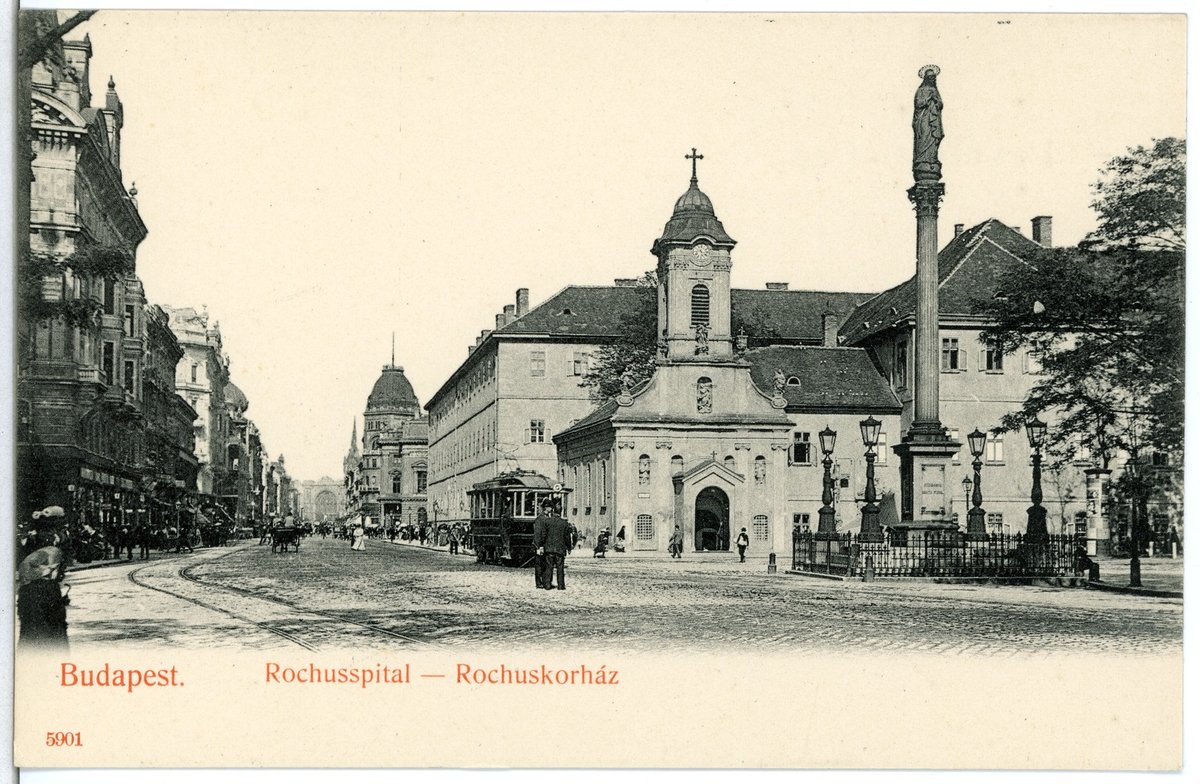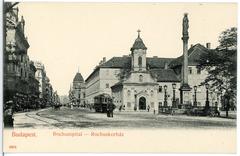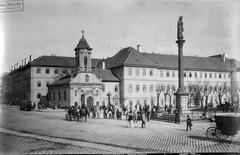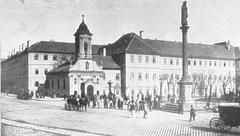
Saint Roch Hospital Budapest: Visiting Hours, Historical Significance & Visitor Guide
Date: 15/06/2025
Introduction
Located in the heart of Budapest, Saint Roch Hospital (Szent Rókus Kórház) stands as a testament to over two centuries of medical innovation, cultural resilience, and social commitment. Established in response to devastating plague epidemics in the late 18th century, it was purposefully founded beside the Chapel of Saint Roch, intertwining public health and spiritual solace. Over the years, the hospital has adapted to the city’s evolving needs, playing a pivotal role in epidemic response, social care, and medical education. This guide provides detailed historical insights and essential visitor information, including hours, accessibility, and nearby attractions, making it a valuable resource for history enthusiasts, cultural explorers, and medical heritage seekers (Offbeat Budapest; Semmelweiskiado.hu).
Table of Contents
- Origins and Foundation
- Historical Context: Epidemics & Public Health
- Architectural & Cultural Significance
- Role in Social Care and Public Health Advocacy
- Visiting Hours, Tickets & Practical Tips
- Accessibility and Guided Tours
- Nearby Attractions
- Frequently Asked Questions (FAQ)
- Visual Gallery
- Summary & Call to Action
- References
Origins and Foundation
Saint Roch Hospital traces its roots to the early 18th century, when repeated plague outbreaks threatened Budapest’s population. Situated beside the Chapel of Saint Roch—built in 1711 as a votive offering following a devastating epidemic—the hospital was located on the city’s then-outskirts (Rákóczi út) to help contain infectious diseases (Offbeat Budapest; Alle Travel). The veneration of Saint Roch, renowned throughout Europe as a protector against plagues, imbued the site with spiritual and communal significance. Jesuit efforts to import Saint Roch’s relics from Rome further established the hospital as both a place of pilgrimage and healing.
Historical Context: Epidemics & Public Health
Budapest’s status as a trade and migration hub made it especially vulnerable to epidemics, including plague and cholera (Wikipedia: History of Budapest). In the 18th century, authorities established epidemic hospitals on city peripheries to reduce contagion risks. Saint Roch Hospital exemplified this approach, merging medical care with spiritual comfort (We Love Budapest).
Throughout the 19th and 20th centuries, the hospital expanded its role, becoming integral to medical training, public health, and emergency response during crises such as cholera, Spanish flu, and more recently, COVID-19 (Budapest Hotel Start; Homelessness Impact).
Architectural & Cultural Significance
The hospital complex reflects Budapest’s layered architectural history. The Baroque Chapel of Saint Roch features a richly detailed façade and a marble plaque marking the catastrophic 1838 flood (Offbeat Budapest). Post-war renovations and the discovery of medieval foundations beneath the chapel, now visible in an added sanctuary, offer visitors a tangible link to the city’s medieval past. The main hospital building, constructed in 1798 and expanded in the 19th century, showcases late Baroque and early Neoclassical styles, with modern wings blending historical and contemporary medical design (Alle Travel).
Role in Social Care and Public Health Advocacy
Saint Roch Hospital’s mission has always included care for marginalized communities. In recent years, it remains Budapest’s only hospital equipped to serve homeless populations, providing 75 beds and treating over 1,000 people annually (Homelessness Impact). During the COVID-19 pandemic, it offered isolation and vaccination services for vulnerable groups, emphasizing its essential role in public health and social justice.
The hospital is also known for its partnerships with NGOs and municipal agencies, offering holistic care including medical treatment, social services, and reintegration programs. Its reputation as a beacon of health equity and social commitment is well recognized by both professionals and the wider community (Semmelweiskiado.hu).
Visiting Hours, Tickets & Practical Tips
General Access:
Saint Roch Hospital is an active medical facility; public access is limited to preserve patient privacy and operational integrity. The hospital chapel and historical areas may be visited during special heritage events or by prior appointment.
Chapel & Historical Areas:
- Visiting Hours: Typically 10:00 AM–4:00 PM on weekdays for special tours or events; always confirm in advance.
- Tickets: Entry is usually free, though donations are welcomed for preservation. Guided tours may involve a nominal fee.
- How to Arrange a Visit:
- Contact the hospital administration by phone: +36 1 455 5700
- Reach out via the official website or Budapest tourism offices for tour availability.
Practical Tips:
- Plan your visit during weekdays for better access and fewer crowds.
- Wear comfortable shoes; some areas involve stairs or uneven surfaces.
- Photography may be restricted in patient areas.
- English is spoken by some staff, but Hungarian is the primary language; be prepared for language barriers.
Accessibility and Guided Tours
Accessibility:
The hospital grounds are partially accessible. The chapel and sanctuary involve stairs, which may limit access for visitors with mobility impairments. Contact the hospital in advance to discuss specific needs.
Guided Tours:
- Tours focusing on architectural and historical highlights are occasionally available by appointment.
- Most tours are conducted in Hungarian and English; confirm language when booking.
- Tours include the Baroque chapel, historic facades, and select preserved wards or archives.
Travel Tips:
- The hospital is centrally located in the Palace District (Gyulai Pál utca 2, 1085 Budapest).
- Public Transport:
- Metro: Blaha Lujza tér (M2 Red Line), 5-minute walk
- Tram: Lines 4 and 6 (Blaha Lujza tér stop)
- Bus: Several lines nearby
- Limited street parking; public transport is recommended.
Nearby Attractions
Saint Roch Hospital’s central location allows visitors to explore several major Budapest landmarks:
- Dohány Street Synagogue: The largest in Europe, a key part of Budapest’s Jewish heritage.
- Hungarian National Museum: Exhibiting national and medical history.
- Uránia National Movie Theater: Historic cinema with eclectic architecture.
- Palace District: Rich in architectural beauty and vibrant local culture.
- Hospital in the Rock Museum: Unique underground wartime hospital (Hospital in the Rock).
Frequently Asked Questions (FAQ)
Q: What are the visiting hours for Saint Roch Hospital Budapest?
A: Access is generally by appointment or during special events, usually on weekdays from 10:00 AM to 4:00 PM for the chapel and historical areas.
Q: Is there an admission fee?
A: No general admission fee; donations may be welcomed. Guided tours may have a nominal charge.
Q: Can I join a guided tour?
A: Yes, but only by advance booking. Contact the hospital or Budapest tourism offices.
Q: Is the hospital accessible for people with disabilities?
A: Partial accessibility. Some historic areas have stairs—contact the hospital to discuss accommodations.
Q: Are patient wards open to visitors?
A: No. Patient areas are not accessible to ensure privacy and safety.
Q: How do I reach Saint Roch Hospital?
A: Centrally located, easily accessible by metro, tram, and bus.
Visual Gallery
- Baroque Chapel of Saint Roch with 1838 flood plaque (alt: Baroque facade, Saint Roch Chapel, Budapest)
- Interior of the sanctuary displaying medieval foundations (alt: Medieval foundations beneath Saint Roch Chapel)
- Main hospital building on Rákóczi út (alt: Historic exterior of Saint Roch Hospital, Budapest)
- Historical map marking hospital’s early peripheral location (alt: 18th-century Budapest map showing Saint Roch Hospital)
Summary & Call to Action
Saint Roch Hospital Budapest occupies a unique place in the city’s heritage, blending medical innovation, social care, and architectural history. Its legacy as a haven for vulnerable populations and a center of resilience during crises continues today. For those interested in Budapest’s medical, social, or architectural history, arranging a visit to Saint Roch Hospital—especially via guided tours—offers invaluable perspective. Combine your experience with exploration of nearby attractions for a comprehensive view of Budapest’s cultural fabric.
For updated visitor information, tour opportunities, and curated guides, download the Audiala app and follow local tourism platforms.
References
- Offbeat Budapest
- Alle Travel
- Wikipedia: History of Budapest
- We Love Budapest
- Budapest Hotel Start
- Semmelweiskiado.hu
- Homelessness Impact
- Budapest City Guide
- Hospital in the Rock Museum
- Budapest Tourism Official Site












































































































































































